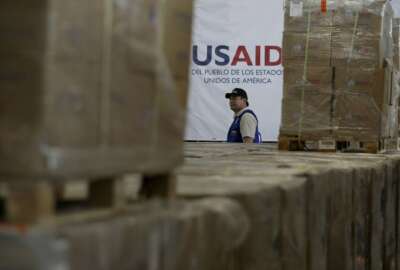USAID tightens up its approach to working with overseas religious groups
The U.S. Agency for International Development (USAID) works with commercial contractors and non-profits in countries where it operates. For many years, that has...
The U.S. Agency for International Development (USAID) works with commercial contractors and non-profits in countries where it operates. For many years, that has included religious organizations. Now, USAID has established a formal policy for religious engagement. For the details, the Federal Drive with Tom Temin spoke with Amanda Vigneaud, the Acting Director of its Center for Faith-based and Neighborhood Partnerships.
Interview Transcript:
Amanda Vigneaud Well, USAID has been working with local religious communities and faith based organizations since its inception. So for over 60 years, they’ve been essential partners in our work in sustainable development and humanitarian assistance in a variety of sectors. That includes food security, strengthening health systems, building climate resistance infrastructure, advancing pluralism. And the policy highlights some concrete examples of the work that we do and how that’s advancing the overall mission of USAID. But I think it’s important to step back and to talk a little bit about the why, why we’ve done this work in so many places, why we’ve done it for so long. And that is in part due to the fact that religious communities, whether they’re formal or informal, whether they’re global or local, are in every part of the world. So in many of the places where USAID works, we know that religion plays a significant role in daily life. And some countries where USAID has a presence, individuals are reporting high levels of religious commitment, sometimes upwards of 80 or 90%. And that for us is more than just a data point. It’s an opportunity for learning, it’s an opportunity for engagement. And it’s critical to advancing locally led development, both in how we engage with civil society, but also in how we advance our results in our outcomes. The other thing that I think is important to note is that we know, and this is from 60 years of lived experience, that religious communities bring distinct contributions in development and humanitarian assistance. Whether that’s history and presence, because they’ve been there often longer than IT development professionals have been. Their work predates even USAID existence, but they also bring trust and influence. They have access to reach vulnerable populations that government officials may not. All of those things working together, again, represent opportunities for positive engagement. And that intentionality is critical for us being able to advance our outcomes.
Tom Temin It sounds almost as if they can provide moral support for someone laying a concrete pipe, because you wouldn’t go to a church or a mosque. Probably they don’t have the capability of digging ditches and laying pipes or whatever the project might be or fixing up the electrical grid. But for people that may not trust machinery and contractors coming in and this kind of thing, the local religious leader might be able to say, it’s ok, it’s good money and it’s going to be a good project, so to speak.
Amanda Vigneaud Well, I think something that we see is a holistic approach, and that’s distinct in religious communities and faith based organizations. They are not thinking of one program or one project. They’re thinking about the whole community and they’re often thinking about the whole person. And as we think about upholding human dignity, that’s a really vital piece of the puzzle.
Tom Temin And do these religious organizations, do they get money from USAID for specific tasks, or do you just maybe enlist them, as, I don’t know, volunteer partners to help alongside with the contractors and work doing nonprofits that are also involved.
Amanda Vigneaud So it ranges. In strategic religious engagement at USAID is an intentional and it’s an evidence based approach, but we define it as the process of collaborating and partnering with religious communities and faith based organizations, both globally and locally. And so it could look like making an award to a faith based organization, but it could look like broader civil society engagement and stakeholder consultations to identify the priorities of individuals and organizations in the community that perhaps we haven’t engaged yet. And I would say the last piece of that definition, which is so critical, is the overall goal of our religious engagement efforts, is to advance our shared development and humanitarian goals. And that word shared is really intentional. And it’s so important because it underscores the principle of mutuality upon which locally led development is predicated. And that has to do with identifying what is common between us so that we can intentionally and jointly pursue this vision of a better world. That’s the strategic part. We get the question a lot, what makes it strategic or religious engagement? For me, it’s a question of how do we work together more effectively, bringing the best of our resources to bear on a particular development or humanitarian challenge. That’s more than a meeting, and that’s more than a one off transactional engagement. That’s a strategic approach that we apply to doing development in a way that’s more inclusive and hopefully more impactful.
Tom Temin We were speaking with Amanda Vigneaud. She is director of the Center for Faith-Based and Neighborhood Partnerships at the U.S. Agency for International Development. And let’s get to the new policy that you have for religious engagement. As you mentioned, USAID has been using religious organizations, partnering with them for 60 years. Why a policy now? And what does the policy intend to do here?
Amanda Vigneaud Absolutely. So USAID, like I said, has been engaging faith based communities for a long time. And when we look back across the decades, we see these moments in recent U.S. history where concrete steps, signposts, so to speak, have signaled to our workforce that this is important, valuable work. So ten years ago, for example, we saw the release of the 2013 U.S. National Strategy on Religious Leader and Faith Community engagement. And that strategy called on U.S. government officials to develop and deepen their relationships with religious leaders and faith communities as they carry out their foreign policy responsibilities. And then 20 years ago, we saw the creation of the first White House and subsequently first USAID faith based office, which was designed to help us institutionally build bridges with faith communities. And so the creation of our office was originally constituted by executive order, but has been reconstituted by every administration since.
Amanda Vigneaud So going back to Feb. 14, 2021, President Biden released an executive order that reconstituted the work of our office and specifically called on USAID to enhance our engagement with development and humanitarian practitioners who are in religious communities. And so in many ways, as we look back over the decades, there have been these moments of intentionality. And USAID’s new Building Bridges policy really builds upon these moments as we endeavor to equip our workforce with the tools and the knowledge to engage religious actors in principle and in practice. But the last thing I want to throw in here, and I think it’s really important, is that in addition to this legacy work and these sort of signposts along the way, when we look at USAID right now, the moment we’re in, it’s really strategic that we’ve been able to release the policy under the administrators vision for an agency for inclusive development. When we think about driving progress beyond programs, the agency’s localization agenda, its prioritization of inclusive development and [Diversity, Equity, Inclusion, and Accessibility (DEIA)], the diversification of our partner base. Strategic religious engagement is part and parcel of all of these efforts.
Tom Temin And what happens when a particular religious group might have the total respect of the community there, but their practices and beliefs might run crossways from what is accepted cultural practice here in the rich old West, where only 5% of the people even set foot in a church anymore, for example.
Amanda Vigneaud I think part of what’s critical in the policy articulates this, we have to be mindful that the policy was not created in a vacuum. So at USAID, we have the safeguards and the guardrails in place to identify the partners that are best suited for the jobs on the ground. And so being mindful of that and ensuring that the relationships that we are cultivating over time are done on our part with full respect and inclusivity, but also done in compliance with the legal requirements that we have as an agency, is critical to effective development results at the end of the day.
Tom Temin Right. So I guess specifically suppose some religious group says, well, women can’t do this type of thing, they can only do this kind of thing. You have to make a decision at some point.
Amanda Vigneaud Well, and I think that’s where it comes down to how USAID has been partnering for 60 years. So the Strategic Religious Engagement policy is about enhancing the engagement that we have with community members. But the contracting decisions that we make as an agency are guided by nondiscrimination policies that are guided by principles and inclusive development, and how we integrate that across the program cycle. So this is part and parcel of how we think about enhanced community engagement. But it’s not prioritizing the beliefs of individual religious communities or faith based organizations above the guardrails that the agency has already set to ensure best practices in our work around the world.
Tom Temin Well, it sounds interesting and it sounds like there is a good, I guess, statutory basis for this. And now there’s an executive order reconstituting it, and the policy reading it doesn’t look all that prescriptive as far as policies that you generally read in the government. It seems more descriptive than prescriptive. Fair way to put it?
Amanda Vigneaud There are different types of policies at USAID. So there’s strategies, there’s policies, there’s vision statements. And so this policy is not a list of ball shelves in government speak. It’s a commitment on behalf of the agency that articulates how we engage with religious communities. And it’s articulating the posture and the principles with which we conduct our engagement. So when we look at the principles, bridges, belonging, respect, inclusion, dignity, growth, equity and sustainability, this is aligned deeply with the values that USAID has and what we’ve really shown over 60 years of work in this space.
Copyright © 2025 Federal News Network. All rights reserved. This website is not intended for users located within the European Economic Area.
Tom Temin is host of the Federal Drive and has been providing insight on federal technology and management issues for more than 30 years.
Follow @tteminWFED





